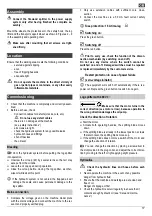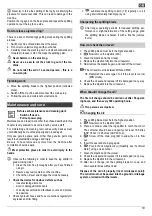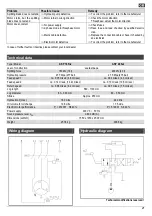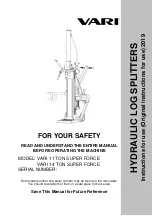
19
Never try to force the splitting of the log by maintaining the
pressure for several seconds. This can lead to damage to the
machine.
Position the log again on the base plate and repeat the splitting
operation or put the log to one side.
How to release a jammed log?
There is a risk of knotted logs getting stuck during the splitting
process.
1.
Switch machine off and disconnect the power.
2.
Do not remove jammed logs with your hands.
3.
Carefully move the stuck log with a crowbar backwards and
forwards to loosen it. Don´t damage the splitting pillar.
Never hammer on the stuck log.
Never use a saw to cut the stuck log out of the ma-
chine.
Do not enlist the aid of a second person - this is a
one-man job.
Finishing work:
Move the splitting blade to the highest position (retracted
state).
Switch off the machine and disconnect the mains plug.
Follow the care and maintenance instructions.
Maintenance and care
Before each maintenance and cleaning work
Switch off device.
Pull out power plug
Maintenance and repair work other than those described in this
chapter is only allowed to be carried out by service staff.
For maintaining and cleaning, removed security devices must
unconditionally be mounted properly and proved again.
Only use genuine spare parts. Other than genuine parts may
result in unpredictable damages and injury.
Be sure to have removed any tools from the machine after
completion of service work.
Wear protective gloves in order to avoid injury to the
hands.
Observe the following in order to keep the log splitter in
good working order:
Clean the machine thoroughly after you have finished
using it.
Remove any resin remains on the machine.
Check the oil level and change the oil as necessary.
Check the device for obvious defects such as
-
loose fastening elements
-
worn or damaged components
-
correctly assembled and faultless covers and protec-
tive devices.
Check hydraulic hoses and hose connections regularly for
any leaks and firm fitting.
Lubricate the splitting column (18) regularly or oil it
using environmentally friendly spray oil.
Sharpening the splitting blade
After longer operating periods, for reduced splitting per-
formance or slight deformation of the cutting edge, grind
the splitting blade or sharpen it with a fine file (remove
burrs).
How do I check the oil level?
1.
The splitting blade must be in the highest position.
2.
Now remove the dipstick (22A).
3.
Clean the dipstick and the oil seal.
4.
Replace the dipstick fully into the oil reservoir.
5.
Now remove the dipstick again, and read off the oil level.
The oil level must lie between MIN and MAX.
Replenish the same type of oil if the level is too low
(MIN or less).
6.
Check the oil seal and replace it if it is damaged in any way.
7.
Replace the dipstick into the oil reservoir.
When should I change the oil?
The first oil change should be carried out after 50 operat-
ing hours, and then every 500 operating hours.
Two persons are required.
Changing the oil:
1.
The splitting blade must be in the highest position.
2.
Now remove the dipstick (22A).
3.
Place a container under the log splitter to catch the old oil.
The container should have a capacity of at least 18.5 litres
(ASP 16 N-2) / 24.5 litres (ASP 20 N-2).
4.
Screw off the drain plug (29) to allow the oil to flow
out.
5.
Insert the seal and drain plug again.
6.
Pour in the new hydraulic oil (Quantity, see “Technical
Data”) using a clean funnel.
7.
Clean the dipstick and the oil seal.
8.
Check the oil seal and replace it if it is damaged in any way.
9.
Replace the dipstick into the oil reservoir.
10.
After an oil change, let the splitting blade move up and
down several times without load.
Dispose of the old oil properly (local oil disposal point).
The old oil must not be poured into the ground or drainage
system, or mixed with other waste.








































